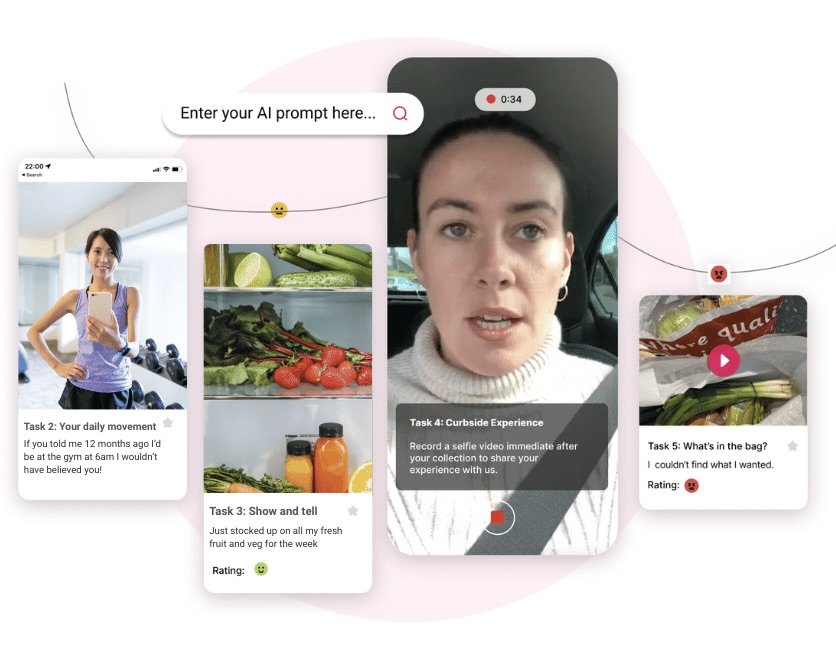Remote qualitative research: how global insight happens without travel
Read time: 6mins
Blog summary:
Remote qualitative research has reinvented how brands explore global consumer behaviour. This article outlines how remote methods preserve cultural nuance, enhance speed, and make multi-country research more human and scalable.
For decades, qualitative research depended on physical presence. Researchers travelled, sat in homes and shops, and immersed themselves in daily life to uncover emotional and behavioural nuance. But proximity no longer requires travel. The rise of remote qualitative research has opened a new pathway to genuine cultural understanding, allowing teams to observe real life as it unfolds without stepping onto a plane.
This shift echoes a broader evolution in research practices, one outlined in our multi-country research playbook. Remote approaches are not just a digital version of traditional fieldwork. They represent a fundamental change in how insight is gathered. Participants document their routines through short videos, photos and diary tasks recorded in the moment. These fragments of everyday life often reveal more authenticity than scheduled in-person interviews. For global brands operating at speed, this change has become essential.
To understand where remote methods fit within modern research, you can explore our guide on asynchronous mobile ethnography, which expands researcher access across demographics and markets.
A new model of global insight
The appeal of remote qualitative research is more than convenience. It aligns with the realities of how global organisations now operate. Campaigns launch simultaneously across regions. Markets evolve faster than annual research cycles. Decision making has compressed from months to weeks.
Remote methods solve these challenges by enabling teams to run multi-market studies in parallel, with participants contributing naturally throughout their day. Because tasks happen in participants’ own environments, the data carries richer contextual detail: tone of voice, gestures, living spaces, product interactions and small but revealing routines.
A major reason global research can now move at this pace is the removal of language friction. With automatic transcription and auto-translation across more than 30 languages, teams can understand what participants are saying and feeling almost as soon as content is uploaded. Instead of waiting days for transcripts or external translation, researchers can begin sense-making while the study is still live, which makes comparisons across markets faster and more accurate.
Industry analysts are observing the same trend. ESOMAR notes that remote qualitative methods have accelerated as brands seek “real-life, real-time” insights at global scale. Harvard Business Review has similarly highlighted the growing relevance of “in-context, participant-led data” for designing culturally sensitive products and experiences.
Designing research that works across borders
Running remote qualitative research across countries requires a design that is structured enough for comparison yet flexible enough to respect local nuance. Simplicity is usually the strongest foundation.
Short, open-ended prompts work well. Asking participants to show the first thing they do when they wake up or capture a moment that felt meaningful invites authentic interpretation across cultures. These tasks create a shared frame for comparison while leaving space for cultural storytelling.
Tone is another important element. A question that sounds warm and conversational in one market can feel abrupt or overly formal when directly translated. Localising tone, not just wording, ensures the tasks feel natural to participants everywhere. Insights Association advises researchers designing cross-cultural studies to translate meaning, not language, to avoid losing emotional nuance.
To dive deeper, see our guide on our for global qualitative research.
Keeping momentum in remote fieldwork
Remote qualitative research moves with a rhythm that differs from traditional fieldwork. Because participants upload content over several days, researchers gain a dynamic timeline of experiences rather than static snapshots.
This rhythm depends on consistency. Reviewing submissions daily helps teams spot emerging themes and follow up with timely probes. A well-timed question, sent shortly after a participant records a meaningful moment, can unlock deeper insights.
Working across countries also requires sensitivity to local routines and time zones. Scheduling prompts to arrive at appropriate times in each market ensures participation feels seamless and respectful. This coordination improves completion rates, reduces fatigue and strengthens the depth of the material captured.
Interpreting insight across cultures
Remote qualitative research often produces a rich blend of video diaries, photos, audio notes and written reflections. Interpreting this material across languages and cultures is where its real value emerges.
Video often becomes the anchor. Emotional cues such as hesitation, excitement or humour carry across languages even before translation. Combined with reflective text and observational footage, these layers help researchers understand both behaviour and the underlying motivations.
Comparing markets side by side reveals universal patterns and culturally specific meanings. In many global studies, the most powerful insights come from these contrasts: the same behaviour expressed differently across cultures, or the same task revealing unique motivations from market to market.
A more human future for global research
The shift to remote qualitative research has broadened who can contribute to global studies. People who could never attend in-person sessions because of geography, caregiving responsibilities, mobility constraints or scheduling challenges can now participate easily through their phones. This accessibility makes global insight more inclusive and more representative.
Most importantly, remote qualitative research creates a new kind of proximity. It is natural, unforced and grounded in real life. It does not dilute empathy. It expands it. By capturing unfiltered everyday experiences across borders, it brings research teams closer to the truth of how people live, choose and feel.
As global brands continue to operate in increasingly interconnected markets, remote qualitative research will sit at the centre of meaningful insight: accessible, agile, culturally fluent and deeply human.
Want to learn more about how we can support you with your next multi country study? Get in touch.


